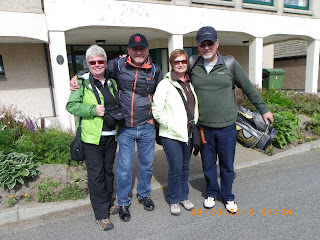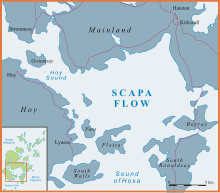Sadly we said goodbye to Alton this Thursday morning and took the Hamnavoe ferry once again only in reverse, from Stromness to Scrabster. Driving south toward Inverness we stopped in Helmsdale for lunch and enjoyed great coastal views. My cousin Stephen was not far from my mind since I knew he would soon be cycling part of this road on his adventure from Lands End to John O'Groats.
We stopped at Cromarty and the Black Isle but only for a quick tour and a look around from the car mainly. We did get out to stretch but did not spend much time.
No heat and sunshine yet as you see but writing this from the perspective of our current heat wave and drought I think I would welcome a cool rainy day right now!
Now back to Craigside in Inverness, Amy and Ewan's B and B, where we had stayed on the way up north. Hmmmm....Inverness is considered to be "north" but we were far beyond that in Orkney! In no time we were basking in the sun room. What a gorgeous and relaxing home within walking distance to down town Inverness and excellent pubs and restaurants. Not that we sampled them all. Only a few minutes walk from Craigside is Castle Pub, right across from Inverness Castle and with enough atmosphere and good food to keep us coming back. We ate there three times! I guess you could call us regulars.
Now another highlight for the golfing Greens! My cousin Stephen, a friend of Ewan, had organized all this for us before we came. It was a treat meeting Stephen on skype video but not nearly as good as meeting the real deal. He drove up from Linlithgow, where he lives with his wife Nina and their 3 children, to golf with John, Ken, Ewan and four others at Castle Stewart. This is a premiere golf course in Scotland and this year the Scottish open was played there. In hindsight that is...we watched it once we were home which was so much fun since John was able to relate to each hill and dale! This is the ultra modern clubhouse of Castle Stewart. It is a gorgeous links course and John thought in some ways it was more challenging than St. Andrew's.

 |
| Undulating greens and fairways. |
 |
| In his glory! |
 |
| Rugged coast of Castle Stewart |
While "the boys" were out flogging Ann and I walked downtown Inverness and enjoyed the shops and views. Because it was Jubilee many towns had some kind of commemorative display. Here you see the unique flower garden of Inverness castle made into emblems.
This is the Victorian Market in Inverness. It is like an indoor mall with many unique shops.
Lovely scenes are within the city. I find this kind of city quite manageable!
Ken and Ann graciously moved around the corner to this B and B, since Craigside was full our last night there. We all enjoyed dinner with Stephen and Ewan at Castle Pub however on our last night. Sunnyholm....hmmmmm....lovely but the name made them think of an old folks home.  |
 |
| Gorgeous gardens at Sunnyholm |
 |
| Ewan, me, Stephen and Johnnie |
Ewan McDonald, World Curling Champion, Olympic Curler for Scotland and B and B host extraordinaire. I will not soon forget our experience here and the kindness of his lovely wife Amy. They are expecting a baby. Stephen, son of my cousin Freda, and the only other relative I have ever met aside from his Mum is a joy to know. Stephen was so much fun and such a golf enthusiast! It was a thrill to receive a phone call from David Murdoch (another famous Scottish Curler) and to come home to tell people I've been hanging out with celebrities. Well Stephen is a celebrity is his own right having done the gruelling bicycle trip from Land's End in England to John O'Groats Scotland, a 900 mile trip!! Stephen raised a substantial amount for Emma's cause, a friends daughter who succumbed to cancer.
Another emotional farewell for me...it was so nice to spend some time with Stephen but hard to say goodbye. The ocean between us is so large. But who knows...maybe we will meet again. Cheerio.

















































